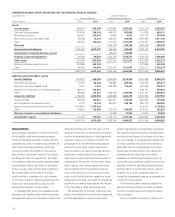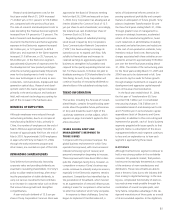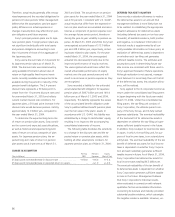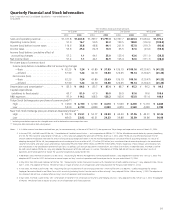Sony 2004 Annual Report Download - page 86
Download and view the complete annual report
Please find page 86 of the 2004 Sony annual report below. You can navigate through the pages in the report by either clicking on the pages listed below, or by using the keyword search tool below to find specific information within the annual report.
84
the amortization of deferred insurance acquisi-
tion costs in the Financial Services segment are
expected to decrease, total expenses for de-
preciation and amortization in the Electronics
and Game segments are expected to increase.
RESEARCH AND DEVELOPMENT
Sony expects research and development costs
(total of expenses for the development of new
product prototypes and expenses for the de-
velopment of mid- to long-term new technolo-
gies) for the fiscal year ending March 31, 2005
to be 550 billion yen, a 7 percent increase
compared with the fiscal year ended March
31, 2004. Research and development costs
associated with process technologies, including
those technologies used in the Game segment,
which were previously recorded in the Game
segment, will be recorded in the Electronics
segment from the fiscal year ending March 31,
2005, due to the integration of the semicon-
ductor businesses in the Electronics and Game
segments. As a result, research and develop-
ment costs in the Electronics segment are ex-
pected to increase more than 10 percent
compared with the 429.4 billion yen recorded
in the previous year. On the other hand, in the
Game segment, overall research and develop-
ment costs are expected to decrease by only
10 percent compared to the 83.4 billion yen
recorded in the previous year. The relatively
small decrease is due to the fact that, although
research and development costs associated
with process technologies will decrease, re-
search and development costs associated with
next generation semiconductor design, new
platforms such as the PSP and software are
expected to increase.
CRITICAL ACCOUNTING POLICIES
The preparation of the consolidated financial
statements in conformity with U.S. GAAP
requires management to make estimates and
assumptions that affect the reported amounts
of assets and liabilities, disclosure of contin-
gent assets and liabilities at the date of the
financial statements and the reported amounts
of revenues and expenses during the report-
ing period. On an ongoing basis, Sony
evaluates its estimates which are based on
historical experience and on various other
assumptions that are believed to be reason-
able under the circumstances. The results of
these evaluations form the basis for making
judgments about the carrying values of assets
and liabilities and the reported amounts of
expenses that are not readily apparent from
other sources. Actual results may differ from
these estimates under different assumptions.
Sony considers an accounting policy to be
critical if it is important to its financial condi-
tion and results, and requires significant
judgments and estimates on the part of
management in its application. Sony believes
that the following represent the critical
accounting policies of the company.
INVESTMENTS
Sony’s investments are comprised of debt and
equity securities accounted for under both the
cost and equity method of accounting. If it has
been determined that an investment has sus-
tained an other-than-temporary decline in its
value, the investment is written down to its fair
value by a charge to earnings. Sony regularly
evaluates its investment portfolio to identify
other-than-temporary impairments of indi-
vidual securities. Factors that are considered by
Sony in determining whether an other-than-
temporary decline in value has occurred include:
the length of time and extent to which the
market value of the security has been less
than its original cost, the financial condition,
operating results, business plans and estimated
future cash flows of the issuer of the security,
other specific factors affecting the market value,
deterioration of credit condition of the issuers,
sovereign risk, and ability to retain the invest-
ment for a period of time sufficient to allow
for the anticipated recovery in market value.
In evaluating the factors for available-for-sale
securities whose fair values are readily deter-
minable, management presumes a decline in
value to be other-than-temporary if the fair
value of the security is 20 percent or more
below its original cost for an extended period
of time (generally a period of up to six to twelve
months). This criteria is employed as a threshold
to identify securities which may have a decline
in value that is other-than-temporary. The pre-
sumption of an other-than-temporary impair-
ment in such cases may be overcome if there is
evidence to support that the decline is tempo-
rary in nature due to the existence of other
factors which overcome the duration or magni-
tude of the decline. On the other hand, there
may be cases where impairment losses are
recognized when the decline in the fair value
of the security is not more than 20 percent or
such decline has not existed for an extended
period of time, as a result of considering specific
factors which may indicate the decline in the
fair value is other-than-temporary.
The assessment of whether a decline in the
value of an investment is other-than-temporary
often requires management judgment based
on evaluation of relevant factors. Those factors
include business plans and future cash flows
of the issuer of the security, the regulatory,
economic or technological environment of the
investee, and the general market condition of
either the geographic area or the industry in
which the investee operates. Accordingly, it is
possible that investments in Sony’s portfolio
that have had a decline in value that are cur-
rently believed to be temporary may determine
to be other-than-temporary in the future
based on Sony’s evaluation of additional infor-
mation such as continued poor operating
results, future broad declines in value of
worldwide equity markets or circumstances in
market interest rate fluctuations. As a result,
unrealized losses recorded for investments may
be recognized into income in future periods.
IMPAIRMENT OF LONG-LIVED ASSETS
Sony reviews the carrying value of its long-
lived assets held and used and long-lived assets
to be disposed of whenever events or changes
in circumstances indicate that the carrying value
of the assets may not be recoverable. This
review is performed using estimates of future
cash flows by product category (e.g. TV display
CRTs) or entity (e.g. semiconductor manufac-
turing division in the U.S.). If the carrying value
of the asset is considered impaired, an impair-
ment charge is recorded for the amount by
which the carrying value of the asset exceeds
its fair value. Fair value is determined using the
present value of estimated net cash flows or
comparable market values.
Management believes that the estimates of
future cash flows and fair value are reasonable;
however, changes in estimates resulting in
lower future cash flows and fair value due to
























